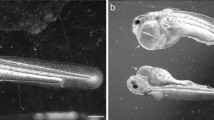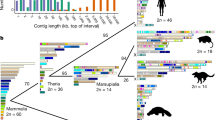Summary
Two diploid platypus cell lines, designated Oa-1F and Oa-2F, have been derived from the toe webs of two females. The development and growth characteristics of the lines are described and G-banded karyotypes presented (the first reported for the platypus). The availability of these lines will greatly facilitate chromosome and gene mapping studies of the platypus and permit the extension of comparative studies of mammalian chromosome and genome evolution to the monotremes.
Similar content being viewed by others
References
Griffiths, M. The biology of the monotremes. New York: Academic Press; 1978.
Crompton, A. W.; Jenkins, F. A., Jr. Origin of mammals. Lillegraven, J. A.; Kielan-Jaworowska, Z.; Clemens, W. A. eds. Mesozoic mammals. Berkeley, CA: University of California Press; 1979: 59–73.
Kemp, T. S. Mammal-like reptiles and the origin of mammals. New York: Academic Press; 1982.
Nash, W. G.; O'Brien, S. J. Conserved regions of homologous G-banded chromosomes between orders in mammalian evolution: carnivores and primates. Proc. Natl. Acad. Sci. USA. 79: 6631–6635; 1982.
Pearson, P. L.; Roderick, T. H.; Davisson, M. T.; Lalley, P. A.; O'Brien, S. J. Report of the committee on Comparative Mapping. 6th International Workshop on Human Gene Mapping, Oslo (1981). Cytogenet. Cell Genet. 32: 208–220; 1982.
Ohno, S. Evolution of sex chromosomes in mammals. Ann. Rev. Genet. 3: 495–524; 1969.
Cooper, D. W.; Johnston, P. G.; Murtagh, C. E.; Sharman, G. B.; Poole, W. E. Sex-linked isozymes and chromosome evolution and inactivation in kangaroos. Markert, C. L. ed. Isozymes III. Developmental Biology. New York: Academic Press; 1975: 559–573.
Graves, J. A. M.; Chew, G. K.; Cooper, D. W.; Johnston, P. G. Marsupial-mouse cell hybrids containing fragments of the marsupial X chromosome. Somat. Cell Genet. 5: 481–489; 1979.
Donald, J. A.; Hope, R. M. Mapping a marsupial X chromosome using kangaroo-mouse somatic cell hybrids. Cytogenet. Cell Genet. 29: 127–137; 1981.
Pye, D.; MacGregor, A.; Stanley, J. F. Marsupial cells in long term culture. In Vitro 13: 232–236; 1977.
Dawson, T. R.; Grant, T. R.; Fanning, D. Standard metabolism of monotremes and the evolution of homeothermy. Aust. J. Zool. 27: 511–515; 1979.
Seabright, M. A rapid banding technique for human chromosomes. Lancet (2): 971–972; 1971.
Eichenbaum, S. Z.; Krumins, E. J. A simple and reliable method of chromosome banding for prenatal cytogenetics using a bromodeoxyuridine pulse. Prenatal Diagnosis 3: 1–6; 1983.
Leversha, M.; Sinfield, C.; Webb, G. Rapid and reliable methods for the G- and C-banding of human and other mammalian chromosomes. Aust. J. Med. Lab. Sci. 1: 139–143; 1980.
Rubin, H. A substance in conditioned medium which enhances the growth of small numbers of chick embryo cells. Exp. Cell Res. 41: 138–148; 1966.
Rein, A.; Rubin, H. Effects of local cell concentrations upon the growth of chick embryo cells in tissue culture. Exp. Cell Res. 49: 666–678; 1968.
Ferguson-Stanley, J.; Pye, D.; MacGregor, A. Comparison of doubling numbers attained by animal cells with life span of species. Nature 255: 158–159; 1975.
Martin, G. M.; Sprague, C. A.; Epstein, C. J. Replicative life-span of cultivated human cells. Effects of donor's age, tissue and genotype. Lab. Invest. 23: 86–92; 1970.
Graves, J. A. M.; Hope, R. M. Fusion and hybridization of marsupial and eutherian cells. I. Growth of marsupial cells. Aust. J. Biol. Sci. 30: 445–449; 1977.
Hayflick, L.; Moorhead, P. S. The serial cultivation of human diploid cell strains. Exp. Cell Res. 25: 585–621; 1961.
Macieira-Coelho, A.; Azzarone, B. Aging of human fibroblasts is a succession of subtle changes in the cell cycle and has a final short stage with abrupt events. Exp. Cell Res. 141: 325–332; 1982.
Bick, Y. A. E.; Sharman, G. B. The chromosomes of the platypus (Ornithorhynchus: Monotremata): Cytobios 14: 17–25; 1975.
Murtagh, C. E. A unique cytogenetic system in monotremes. Chromosoma 65: 37–57; 1977.
Pathak, S.; Stock, A. D. The X chromosomes of mammals: karyological homology as revealed by banding techniques. Genetics 78: 703–713; 1974.
Rofe, R. G-banding and chromosomal evolution in Australian marsupials. Univ. of Adelaide, South Australia; 1979. Thesis.
Ohno, S. Sex chromosomes and sex-linked genes. Springer-Verlag, Berlin; 1967.
Author information
Authors and Affiliations
Rights and permissions
About this article
Cite this article
Wrigley, J.M., Marshall Graves, J.A. Two monotreme cell lines, derived from female platypuses (Ornithorhynchus anatinus; Monotremata, mammalia). In Vitro 20, 321–328 (1984). https://doi.org/10.1007/BF02618595
Received:
Accepted:
Issue Date:
DOI: https://doi.org/10.1007/BF02618595




